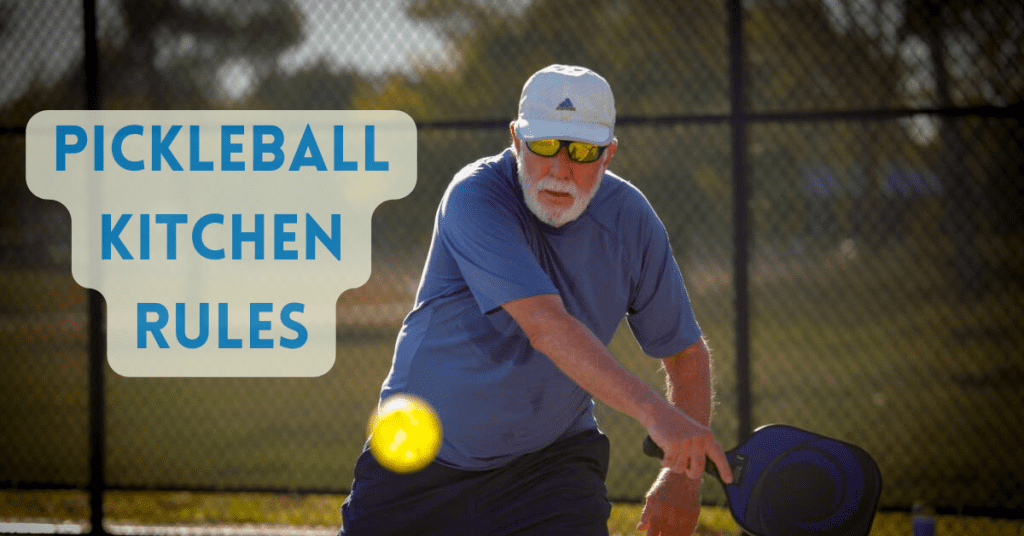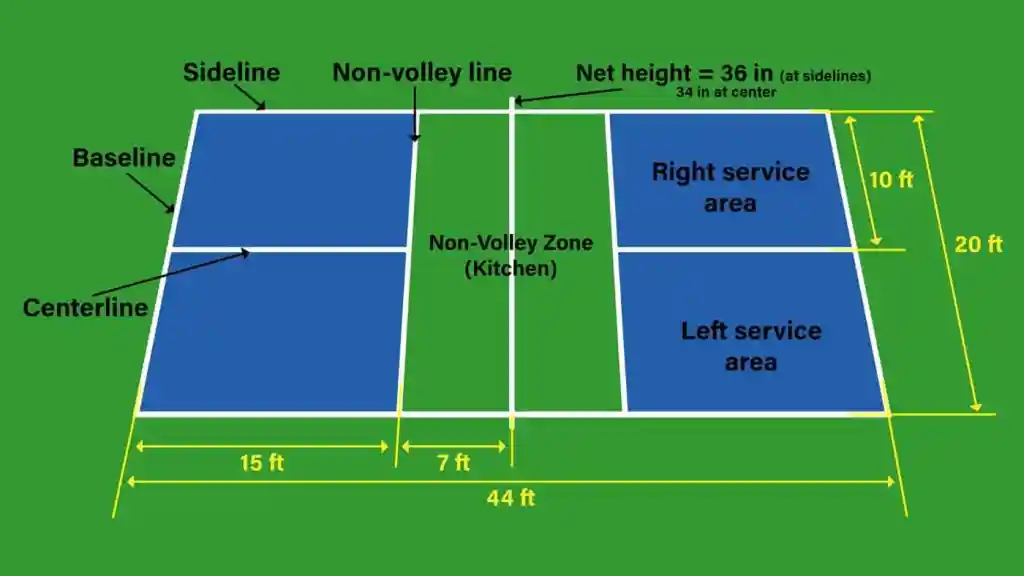
Ever imagined a world where tennis, badminton, and ping-pong walk into a bar and decide to have a love child? Enthralling, isn’t it? That’s pickleball for you. A sport that has bounced into the spotlight in recent times, captivating racquet-sport veterans and novices alike. And let’s not forget the quirky yet tantalizing enigma at the heart of this pulsating game—the “kitchen.” Trust us, it’s not where we cook up a mean stir-fry, but it’s no less spicy in the realm of pickleball. This significant patch of the court cooks up a dash of excitement with its own set of rules.
First things first, let’s define the pickleball kitchen. The kitchen, also known as the non-volley zone (NVZ), is the 7-foot area on both sides of the net. It’s affectionately called the “kitchen” because, just like in a game of “hot potato,” things heat up in there real quick.
Now, let’s break down the kitchen rules in simple, digestible bites (pun intended.): Mastering the Pickleball Kitchen Rules: All You Need to Know
Pickleball is a sport for everyone, and it’s more popular than ever. But if you’re new to the game, or even just new to our space, you might be wondering what makes pickleball different from other sports. Well, let us tell you: it all comes down to the pickleball kitchen rules.
The kitchen rules are unique to pickleball because they’re based on your kitchen—literally. So if you’re wondering where they came from or how they work, or even why they exist at all… well, that’s where we come in.
In this comprehensive guide to everything you need to know about the kitchen rules, we’re going to help you understand them and master them so that one day soon—maybe even today—you can serve up a heaping helping of juicy pickleball knowledge (and then take it home with you).
Welcome to the Wonderful World of Pickleball
Chapters
Toggle
The wonder of pickleball is that it’s at once familiar, yet also a little bit different from traditional sports. As with any sport, it takes practice to truly master the game. In the world of pickleball, it’s not only about mastering the core skills; it’s about understanding the unique set of rules like a seasoned chef knows their way around a kitchen (pun intended.).
But don’t worry. Before we dig into that plateful of pickleball kitchen rules, let’s take a moment to appreciate the game that has us all dill-ighted to grab a paddle.
Picture this: you’re on a court that’s the perfect amalgamation of tennis, badminton and ping-pong. You’re wielding a paddle and a wiffle ball, ready to show off your skills on a court that’s just the right scale for doubles badminton. In the world of pickleball, it’s not only about mastering the core skills; it’s about understanding the unique set of rules like a seasoned chef knows their way around a kitchen (pun intended.).
Why Pickleball Kitchen Rules are the Bee’s Knees
But enough about sandwiches and kitchens, let’s pickle your curiosity. Why exactly are kitchen rules the pièce de résistance of pickleball? Well, here’s the secret sauce: these rules ingrain strategy into the heart of the game. If you’re searching for a sport that levels the playing field (quite literally.) and lets everyone’s inner athlete shine, pickleball is your jam.
Implemented in the non-volley zone, kitchen rules might seem like a pickle at first, but they’re designed to make the game challenging AND enjoyable. Seriously—where else can you find a game that spices things up like a hot sauce on game night?
Embrace the Fun, Get to Know the Game
Pickleball is cool, like a cucumber, but also a thrill, like a rollercoaster ride. If you’re just getting into it, be ready to love every minute on the court. You’ll learn the rules (particularly those kitchen ones), polish your skills, and tango with victory. Now, let’s dive into that main course and satisfy that insatiable hunger for knowledge and pickleball goodness.
Pickleball Kitchen Rules 101
First things first, let’s define the pickleball kitchen. The kitchen, also known as the non-volley zone (NVZ), is the 7-foot area on both sides of the net. It’s affectionately called the “kitchen” because, just like in a game of “hot potato,” things heat up in there real quick.
Now, let’s break down the kitchen rules in simple, digestible bites (pun intended.):
- No-Volley Rule: You may not hit the ball in the air (volley) while standing in the kitchen. You can only do so if both your feet are completely outside the NVZ.
- Bounce Rule: The ball must bounce once before you’re allowed to hit it inside the kitchen. And when you do, both feet must be grounded outside or touching the NVZ line. No jumping around like a caffeinated kangaroo (too bad, we know).
- Two-Bounce Rule: At the start of each point, the ball must bounce on both the serving and receiving sides before being returned (a.k.a., the “double-bounce” rule). This keeps things fair, fun, and prevents players from overpowering each other. Everyone loves an underdog story.
Now that we know the basics, let’s move on to debunking some kitchen myth-conceptions.er
Pickleball Kitchen Rules Myths & Misconceptions
Myth 1: “If the ball hits the kitchen line, it’s a fault.” FALSE. The kitchen lines are part of the NVZ, and as long as your feet are grounded according to the rules, you’re good to go. Consider the line your friendly neighborhood spider… erm, pickleball web – it’s got your back.
Myth 2: “You can’t enter the kitchen at any time.” Not quite, dear reader. Remember, you can hit the ball in the kitchen after it bounces, and you can even venture in to retrieve wayward balls. Just be sure to abide by the No-Volley rule and don’t linger too long; you wouldn’t want to burn what’s cooking.
Myth 3: “Jumping out of the kitchen and volleying is allowed.” Actually, you can’t. If you’re in the air and any part of your body touches the kitchen, it’s a fault. The kitchen holds a grudge, folks—so when it’s time to leave, be sure to use the door.
Now that we’ve cleared the air, let’s cook up some tasty strategies.
Tips & Strategies to Master the Pickleball Kitchen Rules
- Embrace the Dink. While it sounds like something you’d want to avoid, the dink is your friend. This soft shot lands in your opponent’s kitchen, making them hit a bounce shot. It’s a delicate dance, but when executed well, it’ll have you waltzing your way to victory.
- Control the NVZ Line: Make the kitchen line your home sweet home: occupy it when you can, and use the rules to your advantage. Strategically placing yourself near the line can make it easier to volley and capitalize on weak bounce shots.
- Master the Third Shot Drop: Sounds like a dance move, right? In reality, the third shot drop is a crucial strategy. Aim for a soft arching shot that lands in the kitchen, forcing your opponents to hit upwards and give you a prime opportunity to volley.
Communicate with Your Partner
No one likes a backseat driver, but communication is key in pickleball. Call out when you’re fetching a shot, when to let a ball go, or simply to boost their morale – a well-timed “You got this.” goes a long way.
Let's Get Specific - Breaking Down Those Pickalicious Kitchen Rules
Alright, pickle gang. Let’s get down to the nitty-gritty and break down some of those crunchy kitchen rules. In particular, we’re dishing up the spicy details about pickleball kitchen rules momentum, pickleball kitchen line rules, pickleball rules can you stand in the kitchen, pickleball rules entering the kitchen, and pickleball rules stepping in the kitchen.
I. A Matter of Momentum
Or as we like to call it, the “Don’t Momentum your way into trouble” rule. In the zesty world of pickleball, the kitchen rules aren’t just about where you stand, it’s also about where you land. You may perform an impressive ballet-like leap to return a volley, but if your momentum flings you into the kitchen, that’s a fault. Remember, pickleball is more about control than erratic leaps of faith.
II. Learn To Draw The Line
And speaking of faults, let’s talk about the pickleball kitchen line rules. Here’s the straight line on that: think of the kitchen line as a barrier to your airborne actions. If you’re volleying (striking the ball before it bounces), both your feet should be firmly outside this line. However, if the ball has bounced, feel free to launch your attack from either side of the line. Just keep your feet grounded.
III. Can You Stand In The Kitchen?
Short answer: Yes. Long answer: Yes, but… see, pickleball rules can you stand in the kitchen are all about the bounce. Sure, you can stand in the kitchen, do a little salsa, or even perform a pirouette. But remember, the ball must bounce first before you can hit it in there. So, mind that ball bounce like you mind your pickle juice spill—we wouldn’t want any slippery situations, would we?
IV. The Art of Entering the Kitchen
Pickleball isn’t just a high-energy game—it’s also a gracious host that allows you to step inside its glorious kitchen. But pickleball rules entering the kitchen are a bit like knowing the secret knock to a speakeasy. You’re free to saunter in, but only if the ball bounces first. So watch that bounce, be patient, and respect the kitchen’s boundaries.
V. Hot Footing In The Kitchen
If you’re pondering about pickleball rules stepping in the kitchen, we’ve got your back (and your feet). While it might seem incredibly tempting to step into the kitchen to make an impressive return, remember the golden rule: volleys are a no-go in the kitchen. If you’re leaning to have a foot in the kitchen during a volley, it’s a no-no. Remember, all things bounce-related are cool in the kitchen, but flying balls and floating players? Not as cool.
There you have it, folks. With these tidbits under your belt, you’ll be the Sultan of Serve, the Ruler of the Return, the King or Queen of the Kitchen in no time. So, gear up, take these rules to heart, and always keep it fun, fair, and with a side of pizazz.
Frequently Asked Pickleball Kitchen Rule Questions
Absolutely. As long as the ball has bounced, you can play it inside or outside the kitchen. Just be mindful of your feet placement – don’t spoil your masterpiece with a toe faux pas
Sadly, momentum isn’t a valid excuse. If you land in the kitchen or touch the line after a volley, it’s a fault. So channel your inner ninja and master the art of controlled movements.
Ah, the kitchen—a tantalizing puzzle, isn’t it? Here’s the straight dope: you can’t hit the ball in the air (volley) while you’re in the kitchen. You’ll have to let it bounce first. No air Gordan stunts here, folks.
Step into the kitchen whenever you fancy. There are no bouncers in this nightclub. But remember, you can only return the ball from within the kitchen after it bounces. Other than that, it’s open-house
Think of the kitchen rules like a dance routine: step, bounce, hit, and retreat. You can only hit the ball once it’s bounced inside the kitchen (cue live studio audience gasp) and you must retreat from the kitchen once you hit a volley.
Absolutely. It’s not like walking under a ladder or smashing a mirror; no bad luck involved. You’re free to step into the kitchen any time. But remember, you can’t volley from within the kitchen before it bounces.
If it’s recreational play, any player can raise an eyebrow and yell, “Kitchen fault.” with dramatic flair. But for official matches, it’s the job of trained referees to keep their eagle eyes on the NVZ
Suddenly imagining a paddle suntanning in the kitchen while you sweat those precious calories? Relax, your paddle can stretch out over the NVZ in a volley, but make sure you, the player, and your feet stay out. Touching the NVZ is considered a fault.
Yes. The serve can land in the kitchen. Give it a hearty serve, and if it lands in your opponent’s kitchen, you’re still good to go. It’s not out, and play continues.
Pickleball scoring is like a three-course meal: the first number is your score, the second is your opponent’s score, and the final one is the serving team’s number. You score points only when your team is serving, and matches are usually played to 11, 15, or 21 points.
In pickleball terms, a fault is simply a boo-boo that gives the point or service to the other team. It can be anything from hitting the ball out of bounds, stepping into the kitchen before the ball bounces, or even missing the ball entirely (hey, it happens to the best of us).
Conclusion & Resources
We hope this deep dive into pickleball kitchen rules has been equal parts enlightening, entertaining, and hunger-inducing. Remember, practice makes perfect, so get out there and crush those dinks, conquer the line, and cherish every moment on the court.
For additional resources, check out the following links:
Official USAPA Rulebook
Pickleball Kitchen Strategies Video Guide
The Ultimate Dink Tutorial
Now go forth and dominate the pickleball kitchen. Remember: stay out of the heat, but never be afraid to bring it.
Sharing is caring!
